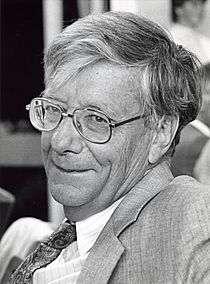Nicolaas Bloembergen facts for kids
Quick facts for kids
Nicolaas Bloembergen
|
|
|---|---|

Bloembergen in 1981
|
|
| Born | March 11, 1920 |
| Died | September 5, 2017 (aged 97) |
| Citizenship | Netherlands United States |
| Alma mater | Leiden University University of Utrecht |
| Known for | Laser spectroscopy Non-linear optics Motional narrowing Photon upconversion Atomic line filter Second-harmonic generation BPP theory |
| Spouse(s) |
Huberta Deliana Brink
(m. 1950) |
| Awards | Oliver E. Buckley Condensed Matter Prize (1958) Stuart Ballantine Medal (1961) National Medal of Science (1974) Lorentz Medal (1978) Nobel Prize in Physics (1981) IEEE Medal of Honor (1983) Dirac Medal (1983) |
| Scientific career | |
| Fields | Applied physics |
| Institutions | University of Arizona |
| Doctoral advisor | Cornelis Jacobus Gorter |
| Other academic advisors | Edward Purcell |
| Doctoral students | Peter Pershan Yuen-Ron Shen Eli Yablonovitch |
Nicolaas Bloembergen (born March 11, 1920 – died September 5, 2017) was a Dutch-American physicist. He won the Nobel Prize for his important work in developing the ideas behind nonlinear optics for laser spectroscopy. During his career, he was a professor at Harvard University and later at the University of Arizona.
Bloembergen shared the 1981 Nobel Prize in Physics with Arthur Schawlow and Kai Siegbahn. Their work greatly improved our understanding of how matter is made up. This was achieved by using laser spectroscopy. Bloembergen was specially recognized for creating a new area of science called non-linear optics. He did this by mixing "two or more beams of laser light" to create new laser light with different properties. This helped to greatly expand how laser spectroscopy could be used.
Contents
Early Life and Education
Nicolaas Bloembergen was born in Dordrecht, Netherlands, on March 11, 1920. His father was a chemical engineer. In 1938, Bloembergen started studying physics at the University of Utrecht. However, during World War II, the German authorities closed the university. Bloembergen had to hide for two years during this time.
Scientific Career
Graduate Studies and Early Research
After the war, in 1945, Bloembergen moved from the Netherlands to the United States. He went to Harvard University to continue his studies with Professor Edward Mills Purcell.
Just six weeks before Bloembergen arrived, Professor Purcell and his students discovered nuclear magnetic resonance (NMR). Bloembergen was hired to help build the very first NMR machine. His work on NMR systems was a big step towards modern MRI machines. MRI machines are now used to look inside our bodies without surgery.
Bloembergen's research also led him to be interested in masers. Masers were invented in 1953 and were the first step towards creating lasers.
In 1947, Bloembergen went back to the Netherlands. He finished his Ph.D. at the University of Leiden in 1948. His thesis was about "Nuclear Magnetic Relaxation."
Becoming a Professor
In 1949, Bloembergen returned to Harvard University. He became an associate professor in 1951. He then became a full professor in Applied Physics in 1957. He retired from Harvard in 1990.
Bloembergen also taught as a visiting professor at other universities. He was at the University of California, Berkeley from 1964 to 1965. Later, in 2001, he became a professor at the University of Arizona.
Developing Laser Spectroscopy
By 1960, while at Harvard, Bloembergen was experimenting with microwave spectroscopy. He improved the maser invented by Charles Townes. In 1956, Bloembergen created a crystal maser, which was more powerful than earlier gas versions.
When the laser was invented, Bloembergen played a key role in developing laser spectroscopy. This method uses lasers to make very precise observations of how atoms are built.
After Peter Franken and others developed second-harmonic generation in 1961, Bloembergen studied what happens when you shine a strong, focused beam of photons (light particles) onto matter. He found that this revealed a new way matter behaves. He called this new area of study nonlinear optics.
Bloembergen explained his work in 1990, saying: "We took a standard textbook on optics and for each section we asked ourselves what would happen if the intensity was to become very high. We were almost certain that we were bound to encounter an entirely new type of physics within that domain."
From his ideas, Bloembergen found ways to combine two or more laser beams. These beams usually had visible light frequencies. By combining them, he could create a single laser beam with different frequencies, like infrared or ultraviolet light. This greatly increased the amount of detail scientists could learn about atoms using laser spectroscopy.
Awards and Recognition
Nicolaas Bloembergen received many awards for his scientific contributions.
- He was awarded the Lorentz Medal in 1978.
- In 2001, he received the Bijvoet Medal from Utrecht University.
- He shared the 1981 Nobel Prize in Physics with Arthur Schawlow and Kai Siegbahn. The Nobel Foundation honored Bloembergen and Schawlow "for their contribution to the development of laser spectroscopy."
Personal Life
Bloembergen met Huberta Deliana Brink, known as Deli, in 1948. They married in 1950. They became citizens of the United States in 1958 and had three children.
Nicolaas Bloembergen passed away on September 5, 2017, in Tucson, Arizona, at the age of 97.
Legacy
On March 11, 2020, which would have been Bloembergen's 100th birthday, a team of scientists published an important article in the journal Nature. They showed that they could control the center of a single atom using only electric fields. This idea was first suggested by Bloembergen back in 1961. This shows how his early ideas continue to influence science today.
Images for kids
See also
 In Spanish: Nicolaas Bloembergen para niños
In Spanish: Nicolaas Bloembergen para niños


